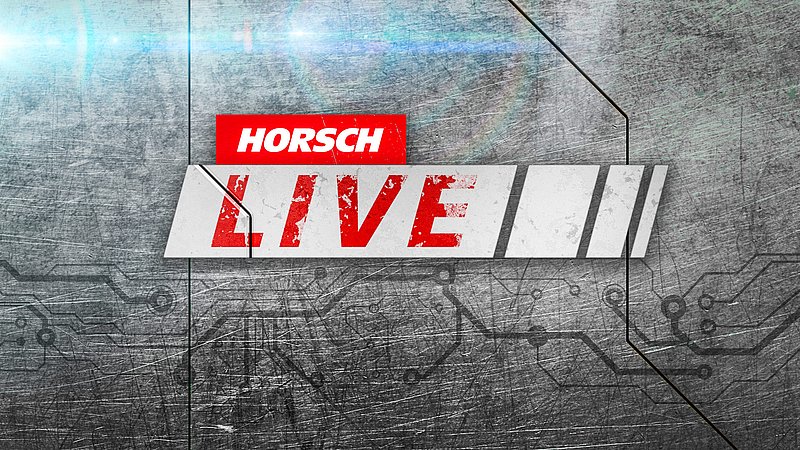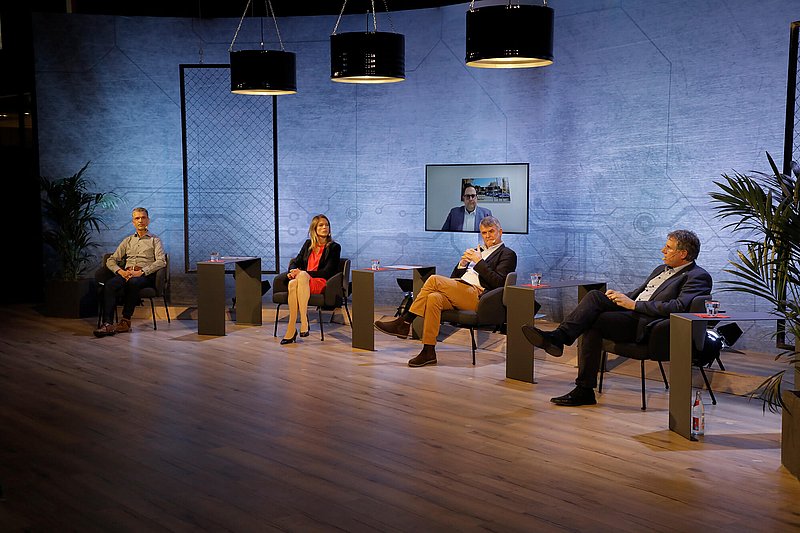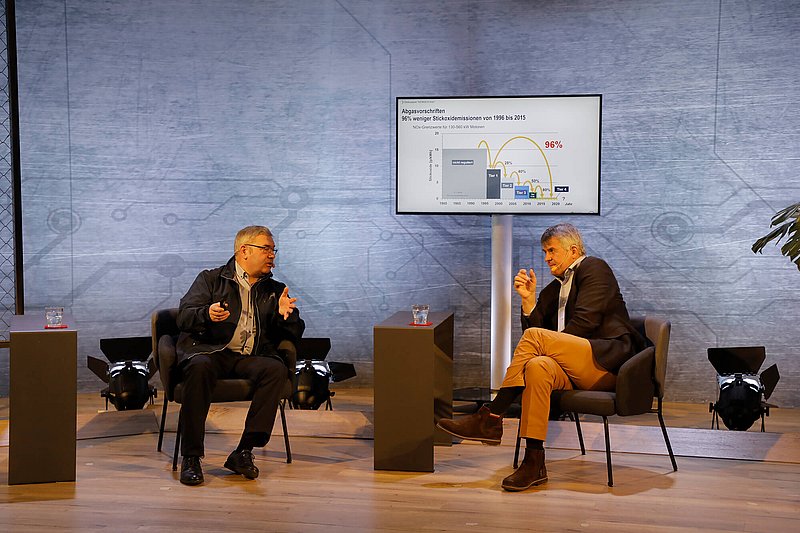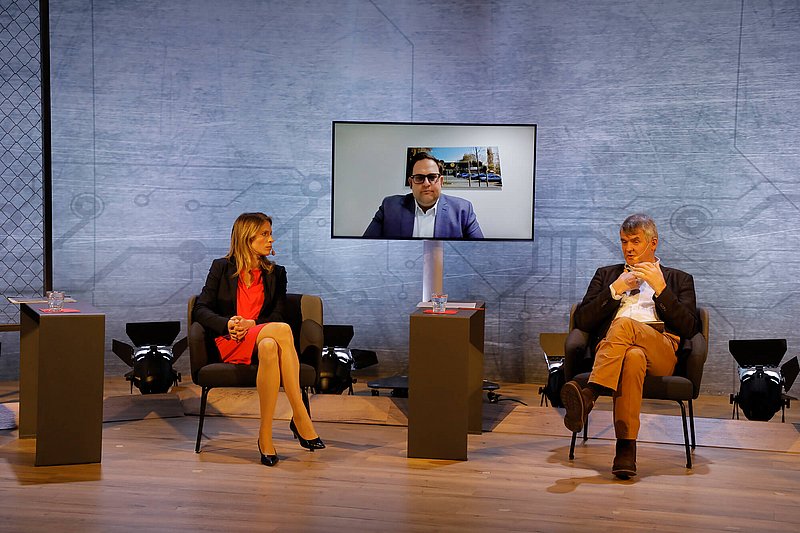
A unique kind of seminar
Because of the Covid-19 pandemic HORSCH offered an alternative to a seminar on site in Schwandorf: a live event with numerous speeches and guest speakers about various topics, among others the future of diesel or the marketing of organic products and organic cereals.
“Another Covid-19 lockdown” many participants might have thought when February approached and thus also the time for the traditional HORSCH seminar at Sitzenhof in Schwandorf. In 2020, too, the seminar had to be cancelled because of the pandemic.
After the very successful field day in autumn 2020 it quickly became clear that this year’s seminar, too, should take place online. However, in a completely new style. A seminar format the whole sector of agricultural engineering has never seen before. The idea of HORSCH Live was born. The speeches with speakers from different countries were spread over three days. In addition to the traditional speeches there also were interesting panel discussions with many professional experts.
Anyone could attend quite simply via YouTube, Facebook or the HORSCH website. The chat forum could be used to communicate with other participants or to discuss. Michael Braun (Sales Support) presented the German part of the event as well as the German Q & A sessions. Johannes Hottenbacher (Regional Sales Manager) presented the English speeches and panel discussions.
To prevent technical problems or connection losses many speeches were recorded in advance. Moreover, the internet connection and the online systems were tested with all speakers to guarantee a smooth course of the live discussions and Q & A sessions. A team built a HORSCH Live studio in the great exhibition hall in Schwandorf where normally the Seminar takes place.
And it was well worth the effort. From 23rd till 25th of February, 2830 people watched the event live and until end of May HORSCH Live had reached a total of 500,000 people!
You will find a more detailed summary of the discussion panels “Will diesel remain the key player in the field?” and “Marketing of organic cereals/organic products now and in the future. What are the chances and risks of a significant increase of the land for organic farming?” in this article.

You can still watch all speeches and discussions.
Storage of CO2 in the soil, direct seed and crop care with microorganisms and bacteria
The second day of HORSCH Live started with the currently much-discussed process of CO2 storage in the soil. In this respect, microbial carbonisation as a composting method and tillage systems for carbon storage were presented.
After that two no-till experts shared their experiences. The first one was Ulrich Zink who talked about the experiences with direct seed of cereals and rape in Central Germany he has been collecting for 20 years. He was followed by the first international speaker Julien Senez. The French farmer also relies on no-till farming and based on real figures from his farm illustrated how the system pays off.
Next came three speeches from the HORSCH portfolio about the topics “Trends in crop care”, “Top quality for wear parts” and “New technology for mechanical population management”.
The second afternoon of the seminar took the audience to Brazil. Farmer Gregory Sanders talked about biological crop care at the farms of Grupo Progresso. He explained the long history of the use of bacteria and microorganisms in Brazil and the enormous progress that has been achieved especially in the past few years. He demonstrated that by using these bio-control measures he saved almost 1 million Dollars per year compared to conventional plant protection measures on his approx. 50,000 hectares in two harvests. The next speaker was Gustavo Hermann from Koppert Biological Systems. His company produces a lot of these bio-control agents and also bio-stimulants as a fertiliser replacement. He showed what will be possible in the future and he provided some insights into the research centres in Brazil which in the meantime focus exclusively on this topic. His company supports measures not only in the soya sector but also for cotton and coffee to make the production process more transparent to show for example when goods are imported how the imported agricultural products were produced – keyword GMO free – not genetically modified.
Hoeing cereals, cultivating soybeans and intercropping
Moritz Lampe (co-founder of the Weser Bio GbR) was the first speaker of the third HORSCH Live day and gave some tips with regard to hoeing cereals with a row spacing of 25 cm. He stated that in his opinion in certain situations the hoe even is a “term life insurance” for the farmer. He recommends to equip the hoe with the maximally possible technology, especially for working very precisely, and to adapt it to the seed drill at all costs, ideally to only one seed drill.
The motto of the contribution about the quality management at HORSCH was “It’s only steel”. It was followed by a speech about the topic Intelligence – a term HORSCH uses to bundle its digital and automated technologies like the new Connect platform which includes for example the analysis, data transfer or service topics for machines.
The managing director of N.U. Agrar, Ferenc Kornis, showed the position of Germany compared to the rest of Europe with regard to the cultivation of soya. He explained what farmers in Germany have to pay attention to regarding soya and under which conditions good and competitive yields can be achieved. For especially for GMO free soya there is a considerable demand for domestic products.
The next two speakers were from Canada. Joel Williams talked about his experiences with intercropping in Canada. Intercropping means that two crops are cultivated and harvested together in one field. Joe Wecker described which crops he uses on his farm for intercropping and what has to be taken into account from sowing over fertilisation and population management till the harvest. Read more about it in the article of this issue.
Constantin Horsch was the final speaker of the third day and, thus, of the HORSCH Live event. Together with his brother Lucas he manages the farm AgroVation in Kněžmost in the Czech Republic. He took the audience on a journey from the beginnings of the farm, over its development as a HORSCH research farm to the current state where already part of the fields has been converted to organic farming.
Alternatives to diesel?
Michael talked to Werner Kübler from MAN Engines, an expert with a long-time experience in the sector of the construction of heavy-duty industry engines, about the topic “Will diesel remain the key player in the field?”
These motors and engines can be found in different market segments and products, among others in truck, buses and railway appliances, in boats and ships, but also in industry and in biogas plants in the agricultural sector. In total, the company produces about 10,000 engines per year, the engine-power class ranging from 50 to more than 2,000 hp. Especially in the agricultural sector, the focus is on the customer and his requirement for the highest possible performance combined with the lowest possible fuel consumption.

Since 1995, diesel engines have been subject to stricter and stricter international emission regulations and have been divided into the regulatory categories Tier 1 to currently Tier 4. In the engine development sector, in addition to the general efficiency, emission reduction plays a major role. The reduction of the NOx nitrogen oxide emissions alone has been amounting to 96 % since 1995. The requirements until Tier 3 were met by a highly improved injection technology and optimisations in the combustion chamber. But already the first approaches for Tier 3 and finally Tier 4 made cleaning catalytic converters obligatory. Almost the same is true for the limited value for particles. In this sector, too, a reduction of approx. 96 % was realised and only emission standard Tier 4 made the use of particle filters necessary. “With regard to the values the emission level we already have today can roughly be compared to Euro 6 for trucks”, Kübler explains. Thus, the engines currently already are quite clean.
What will come after Tier 4? Kübler emphasises that however Europe and the US follow slightly different ways, the objective basically is the same. Farmer have to provide proof for the emission values when practically working in the field.
Even at the highest performance peaks all limit values have to be complied with. Yet all modifications the engineers made at the machines served the power density and the reduced consumption, even if it was triggered by stricter and stricter emission standards, Kübler says.
Already at this time the audience sent questions especially with regard to the efficiency of the new engines with exhaust after-treatment. The farmers and tractor drivers get less power – despite an increased performance on paper – when they step on the accelerator.
Kübler’s explanation is that before 1995 the accelerator was connected directly with the engine and thus reacted promptly. Today, a digital, regulating electronic system which did not exist as such before is installed to reduce emission peaks. This can convey the impression of a certain regulation delay. “Every engine is inspected and tested by the acceptance authority and thus has to effect the indicated performance”, Kübler affirms. The customer also feels the power by the traction via the wheel or at the pto-shaft which could also be a factor for a perceived loss of efficiency.
“It is clear that the engine disposes of the indicated power. But in our perception this power is not the same as that of an old tractor that was not regulated”, Michael Horsch confirms.
When asked about future drive forms, Kübler showed an illustration with different engine and fuel solutions for tractors. The example was a tractor with 139 kW that carries out intensive tillage for 3.5 hours. Among others he compared diesel, liquefied gas (LNG), two different hydrogen systems and an electric motor.
This comparison shows how important the respective weight of the tank together with fuel respectively battery is, but also the required space and the costs for tank, battery and fuel/power themselves.
A pressure tank for gas takes up a lot of room in the installation space. Only the costs for liquid gas are slightly higher than the – comparatively – low costs of the diesel drive. With hydrogen the weight of the tank is three times as high, the capacity is considerably higher, and the tank system is significantly more expensive. For electro drives the battery costs for one day of standard work in the field amount to about 144,000 Euro. In addition, there is a capacity that corresponds to approx. 2400 litres of diesel and a weight of 2.8 tons, Kübler explains. Thus, it is obvious for Michael Horsch: “In the farming sector we won’t get around diesel or a diesel-like fuel.”
Simply replacing diesel by bio diesel is very complex as it first of all has to be esterified to burn up cleanly and efficiently in the engine, Kübler says. If you take the objective of CO2 reduction seriously, you have to rely more and more on renewable energy resp. power from the sun, wind or biomass.
When talking about sustainability you end up with synthetic fuel. Synthetic fuel is generated by using power from sun or wind energy to produce hydrogen by means of an electrolysis process. In combination with CO2 a lot of fuels can be produced from it.
But the problem is the quantity. For the production you need large-scale plants that can produce such fuels at a reasonable price as well as enough power from sun and wind. And there still is the problem of the large-scale supply of the fuel. A completely new filling station network would have to be set up for a start, Kübler says. The turn towards the electric motor shows how difficult this is. “If you think about synthetic fuel […], you actually have to produce a fuel that corresponds to today’s standard. That is a fuel that tomorrow can be used in any diesel vehicle“, Kübler explains.
One question in the live chat was about why MAN and Daimler presented trucks with electric motors. Kübler answered that in this case the legal situation plays an important role.
The manufacturer has to take account of the entire fleet to meet the emission targets and to avoid penalties. At the moment this can only be achieved with electric motors as in this case production is not taken into account and battery-driven vehicles are assessed as zero CO2 emitters. This is why it makes sense to also include e-drives in the fleet to achieve the fleet value respectively to get below the prescribed CO2 limit of the fleet.
Europe and Germany are good at quickly developing and advancing innovations and technology. However, it takes considerably longer to develop an infrastructure and, thus, it will cost money and take time to achieve the climate target, Kübler finished his speech.
More bio in the Covid-19 pandemic – but how will it go on?
The topic of the second HORSCH Live evening was “Marketing of organic cereals/organic products now and in the future. Which chances and risks does a considerable increase of the crop area for organic farming involve?” Michael Horsch discussed with Stefanie Strebel (founder and managing director of KS Agrar GmbH and Ceresal GmbH), Klaus Bergmann (managing director of Bergmann GmbH), Jörg Große-Lochtmann (managing director of Bio Kontor GmbH, Öko Service GmbH as well as chairman of market association of the Naturland farmers) and Christof Mross (managing director of Food Lidl Germany).
In Germany, the attendant circumstances of the Covid-19 pandemic resulted in more and more people questioning their food habits and their buying behaviour. The analysis of the Federal Ministry of Agriculture and Food showed that people consume more ecologically. Factors like environment and climate protection as well as adequate animal housing play a major role. The sales figures of the organic food shops also are a proof for this development. The increase amounts to about 30 %, Michael Horsch says. The trend towards a more sustainable consumption has already begun to show before the Covid-19, Jörg Große-Lochtmann confirms. However, the pandemic has intensified the trend.
The reason why people despite the insecure situation buy more expensive organic products in Klaus Bergmann’s opinion mainly is because people cannot eat out: “People are forced to cook at home. So they have more money left.“ He hopes that this trend will remain after the pandemic or will even increase. According to Stefanie Strebel the increasing trend for organic products also has to do with health prevention during the pandemic. This is why she thinks that this trend will remain beyond the time of the pandemic.

Christof Mross even added some figures on the part of Lidl to these statistics which show this development in a difficult light. Customers whose purchase behaviour already had been price-conscious before the pandemic, now buy in an even more price-conscious way. Customers who purchased ecologically increasingly did so during the pandemic. Consumption habits intensified and increased exponentially. “The gap increased significantly. If you want to transfer this to society a considerable separation has become evident“, Mross says. However, he is convinced that due to the pandemic people pay more attention to what and how they consume and that the trend is here to stay in the long run. This is also proven by the highly frequented farm shops.
Michael Horsch pointed out that a balanced diet also meant a certain abstinence from meat and at the same time asked if this also was another trend. The share of flexitarians – those who eat meat but also consume a lot of vegetarian or vegan products – will continue to increase according to Große-Lochtmann. Not only animals will benefit from this but also the organic farming sector, nature and man. “The German society for food would say: If someone spends all the money a German spends on meat on organic meat, he has eaten exactly the right quantity of meat”, Große-Lochtmann describes his understanding of a healthy flexitarism. Meat consumption in total will continue to decrease. This is also proven by the rising demand for plant-based meat substitutes. But dairy products and fish, too, are more and more replaced by vegetable alternatives. “The food industry really changes everything to plant-based“, Stefanie Strebel adds. This confirms the wish of society for more sustainable and healthier food as well as for more animal welfare.
With regard to the question if it is reasonable for a farmer to convert to organic farming Stefanie Strebel points out that it is particularly important to consider the global market, too. The EU bio label can be found on every organic product in food retailing. But this is not very conclusive for the consumer as organic products can also be imported from Eastern Europe. Thus, the goods can come from anywhere in the world as long as they were produced according to the EU standards for organic products. So there are a lot of competitors as farmers outside the EU because of various factors can produce considerably cheaper. In Strebel’s opinion, the consumer has to get a clearer information about where the food really comes from by for example disclosing a CO2 balance on the products and thus giving the consumer the chance to buy goods from his region.
Though a correct disclosure of the delivery chain and the produced CO2 may be transparent, it implies a lot of effort, says Christof Mross. To arouse the motivation of the consumer for local (organic) food is much easier than disclosing the delivery chain. This is why Lidl’s objective is to replace more and more imported EU organic goods by regional Bioland products. “It does not work to educate the customer and to prescribe what he has to buy“, Mross states. You can only make an offer and let the customer decide. Lidl prefers to motivate the customer than to educate them. In this respect, information is extremely important.
Another objective is to make local organic production more economic without the organic farmer becoming dependent on the governmental subsidies. “There are two options. On the one hand, inform the consumer to make him prefer local organic products and on the other hand, increase our land productivity to make local organic products competitive on an international scale“, Stephanie Strebel explains.
If it still makes sense today to convert to organic farming finally depends on the respective farm, the fields, soils, livestock and also on the regional marketability of the products. According to Jörg Große-Lochtmann the following will happen with the prices if the share of organic products and the yield increase: trade, processors and producer will have to co-operate more closely. If the production quantity in organic farming increases, the trade has to continue to guarantee long-term delivery contracts with good conditions. When some years ago the high demand for spelt was high, even the price for conventional spelt would have increased as there where organic spelt shortages, says Jörg Große-Lochtmann. The price is defined by supply and demand. “In the ecological or in the organic sector the market is different, but it also follows the rules of supply and demand”, Mross adds.
At the end of the entertaining and interesting panel discussion Michael Horsch gave a positive summary. Organic farming definitely has a future and will also be lucrative in the long run beside conventional farming. With regard to climate the whole sector will be accompanied by political guidelines which, however, have to set the same standards for everyone – industry, retailers or farmers. Today, farming offers a lot of innovations and developments. “I think it is very important that we stop setting conventional off against organic farming. The systems have to meet in the middle”, Bergmann says. This is the only way to find a common consensus which will result in a healthier consumption.